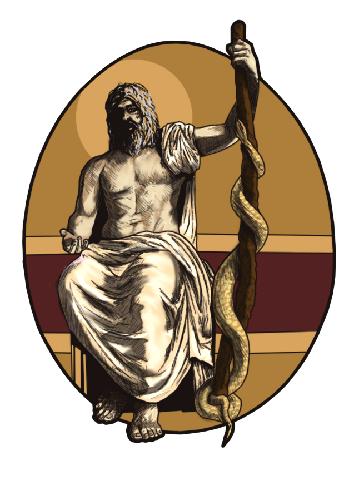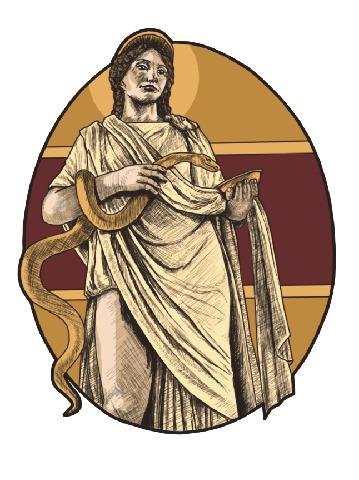Chemical Serpents: Asklepian

The Asklepian, with its single serpent, also suggests the raising of energy, and if we see a parallel between the Ida and Pingala with the Caduceus, we can see another parallel between the serpent of the Asklepian and the Kundalini serpent itself.
Serpents recur as a theme in the myths and practises surrounding the medicine and healing god, Asclepius. In addition to the serpent on his staff, we find depictions of his daughter Hygiea, the goddess of health and disease prevention, draped in a large serpent. In one Orphic hymn, Hygiea plays the role of Asclepius's wife rather than daughter, and her earliest worship seems to be in the form of Athena Hygiea, rather than an independent goddess. Her depictions often show her feeding the serpent from a cup or bowl, nursing it back to health, and just as the asklepian survives today as a symbol of medicine, we find the bowl of Hygiea, usually a bowl or chalice about which coils a serpent, surviving as a symbol of pharmacy. We also derive the modern English word Hygiene from her name, although it actually meant something more like 'well-being', 'wholeness' or 'divine blessing'.

In honour of Asclepius, snakes were used in healing rituals and many non-venomous snakes were allowed to crawl on the floor of the dormitories where the sick slept. The interpretation of dreams played an important role in the healing process of patients, especially dreams received whilst sleeping in the abaton, the holiest part of the healing temple, where new patients slept after making offerings and sacrifices.
The prophet and miracle worker Alexander of Abonutichus founded a second century cult on a glove puppet serpent god, Glycon, which he claimed was a reincarnation of Asclepius. Apparently Glycon started as a serpent inside an egg which Alexander hatched in the marketplace of Abonutichus before an assembled crowd, and within a week this serpent grew into a large serpent with the head of a man, having long blond hair. This was apparently either a puppet, or an actual serpent wearing a mask.
We find another serpent image coiled about a staff in the form of the Brazen Staff of Moses. According to the Bible, Moses used a brass serpent set upon a pole to heal the Israelites in exile from poisonous snake bites they received in the desert. Looking upon the staff cured them of their snakebite. The priestly source of the Torah refers to it as a fiery serpent, like the Kundalini. In Christian mythology Christ compares himself to this serpent in the Gospel of John. Christ was also compared to Asclepius, since both were the sons of a god, and had miraculous healing powers, even able to restore life to the dead. Both also died only to be raised up to heaven, Zeus placing Asclepius in the stars as the constellation of Ophiuchus, the serpent holder.
In 'Secrets of Voodoo', Milo Regaud refers to Simbi as the Voodoo Mercury, messenger of Legba, god of the Sun, who also has the role of psycho-pomp. In Haitian Voodoo the large and diverse family of serpent spirits known as the Simbi, derive from a similar family of serpent water spirits from the Kongo of the same name.
Whilst the Kundalini serpent rising up the spine also resembles the Asklepian, the sleeping Kundalini serpent coils about herself and holds her tail in her mouth. Furthermore, the awakened Kundalini rises up the spine, but also loops back down the front of the body to create an Ouroboros-like circuit.